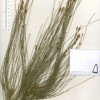Abstract
Australian pine was originally planted in Florida in the late 1800′s as a windbreak and for shade. But soon thereafter it was spreading without help from humans. Today it is considered a category I invasive species in Florida, and the Division of Plant Industry strictly prohibits possessing, transporting, and cultivating this species. For those who find this tree in close proximity to their home, it’s a good idea to replace it since Australian pine is known to have a very low resistance to wind. Australian pine is commonly found growing on coastal shorelines since it thrives in salty, sandy environments. This 2-page fact sheet was written by Michael G. Andreu, Melissa H. Friedman, and Robert J. Northrop, and published by the UF Department of School of Forest Resources and Conservation, July 2012.
FOR298/FR366: Casuarina equisetifolia, Australian Pine (ufl.edu)
References
Duever, L. C. (2004). Casuarina equisetifolia. Retrieved from http://www.floridata.com/ref/c/casu_equ.cfm.
Duryea, M., & Kampf, E. (2007). Wind and trees: Lessons learned from hurricanes (FOR118). Gainesville, FL: UF/IFAS Florida Cooperative Extension Service. Retrieved from http://edis.ifas.ufl.edu/pdffiles/FR/FR17300.pdf. https://doi.org/10.32473/edis-fr173-2007
Florida Exotic Pest Plant Council (2011). Florida Exotic Pest Plant Council's 2011 Invasive Plant Species List. Retrieved from http://www.fleppc.org/list/list.htm.

